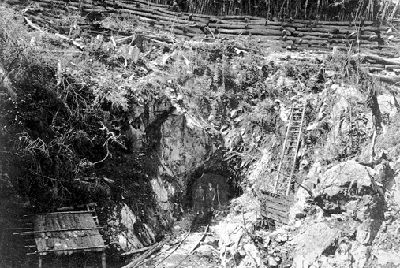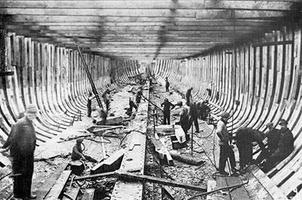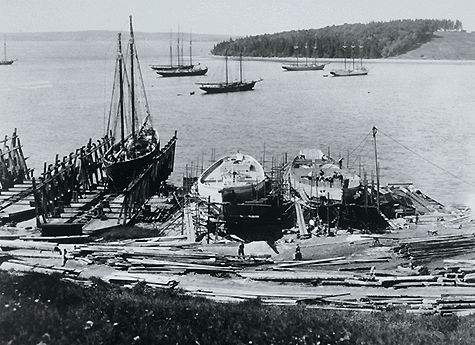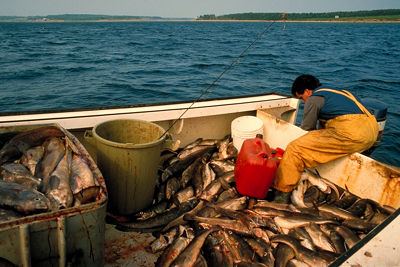This entry is one of three survey entries on the economic history of Canada. (See also Economic History of Central Canada and Economic History of Western Canada.)

Early Economy
Although there was early fur trading, serious economic development in the Atlantic provinces (Nova Scotia, Prince Edward Island, New Brunswick and Newfoundland) really began with the ocean fisheries, whose markets were in Europe and later in the West Indies. Much of the 16th-century fishing was conducted from British and European bases. Settlement was slow, especially in Newfoundland. On the mainland, Acadian settlers arrived during the 17th century, followed by anglophone migrants from Britain and New England in the 18th, but the European population remained small until the arrival of the Loyalists, partly because there were only small amounts of good agricultural land. Early in the 19th century, Scots also settled on Cape Breton. Prosperity came from wooden shipbuilding, the fisheries, forests and maritime carrying trades. Colonial lumber enjoyed preferential treatment in Britain (see Timber Duties), while the carrying trades served the whole Atlantic basin (see Shipping Industry).
Coal and Steel
By the mid-19th century, lumber preferences ended and, in shipping, iron and steam began to edge out wood and sail (see Cunard Company). Cape Breton coal found a market in Boston; other favourable developments were hard to find. Although there were efforts at manufacturing, local markets were small and communications among the colonies were bad. The Intercolonial Railway to the Province of Canada created some new markets for East coast industry, but the line did not eliminate the locational disadvantages. When the Dominion tariff was raised in 1879, many Maritime capitalists built factories, only to find that markets were smaller than they had expected and that new managerial skills were needed. Nor could Maritime coal compete in Ontario with Pennsylvania coal. Bankruptcies and takeovers were numerous. However, iron and steel production in Nova Scotia was stimulated by the tariff, by the Dominion’s iron and steel bounties and by the post-1900 railway-building boom (see Railway History).

By 1900, Halifax had become a local financial centre whose capitalists were raising money not only for local industry, but for utilities in Latin America. But Maritime banks tended to fail, merge or move their executive offices to central Canada (see Bank of Nova Scotia; Royal Bank).
During the 19th century, Newfoundland acquired a settled population largely by immigration from Britain. The rest of the region attracted few migrants, at least after 1867, and the population grew slowly: much of the natural increase flowed to the US or to other Canadian regions.
The 1920s and 1930s were unhappy decades in the Atlantic region. The iron, steel, coal and machinery industries were in chronic difficulty and, like the fishery, they suffered severely in the Great Depression of the 1930s. Nor did new manufacturers make much headway, despite continuing federal subsidies for rail transport. The few rays of hope included new pulp and paper plants and new protected markets for apples and lumber in Britain. The Second World War brought hectic prosperity to those communities that served the naval and air bases, and after 1945 the situation improved. New hydroelectric plants and new governmental initiatives attracted industry, but these programs had some successes and many failures.
New Hopes
By the mid-1980s, offshore oil and gas had been discovered in commercial quantities. As of 2018, four producing deep-sea oil projects, and their associated support industries, were bringing petro-dollars and a new prosperity to the Avalon Peninsula of Newfoundland. Three producing oil and natural gas projects off Nova Scotia were also boosting revenues in that province. But the coal and steel industry in Cape Breton was gone, and other heavy industries such as pulp and paper were in chronic trouble across the region (and the country); those mills that survived were kept alive by government subsidy.
Although the once-great cod and ground-fisheries of Atlantic Canada (see Grand Banks) had collapsed in the 1990s, lobster, shrimp and other shellfish stocks sustained the industry and proved to be a lucrative overseas export product in the 21st century (see Codfish Moratorium). By 2014 Saint John, New Brunswick was being transformed into a major North American energy port, with its Irving Oil refinery and, as of 2008, its Canaport LNG receiving terminal, the first liquefied natural gas terminal in Canada. There were also plans to build a new oil export terminal at the site. Nickel and iron ore mining and smelting in Labrador was another bright spot in a tough, regional economy — along with the promise of a second, massive hydroelectric scheme on Labrador’s Churchill River, a new federal program to build Canadian warships at the Halifax Shipyard, plus a small but growing aerospace sector in Nova Scotia and Prince Edward Island.
Regional Economics — Summary
The Atlantic provinces have produced below-average per-person (per capita) contributions to Canada’s economy in recent decades. Together they accounted for $113.4 billion, or 6 per cent, of Canada’s gross domestic product (GDP) in 2016. Although this was roughly the same percentage as 20 years ago, the make-up of that number has changed dramatically.
Newfoundland and Labrador, once the weakest economic province in the Atlantic region, has benefited from the development of its coveted minerals, hydroelectric capacity and offshore oil, and is regarded as an above-average performer in terms of per-capita GDP output. Despite the devastating closure of the northern cod fishery in 1992 — the largest industrial layoff in Canadian history — fishing and fish processing remains a major economic activity in the Atlantic region (see Codfish Moratorium). The port of Halifax, and to a lesser extent the ports of Saint John, New Brunswick, and St. John's, Newfoundland, are also important economic generators.
One of the region’s biggest ongoing challenges is a lack of population growth and a rapidly aging population.
(See also Regional Economics.)

 Share on Facebook
Share on Facebook Share on X
Share on X Share by Email
Share by Email Share on Google Classroom
Share on Google Classroom





